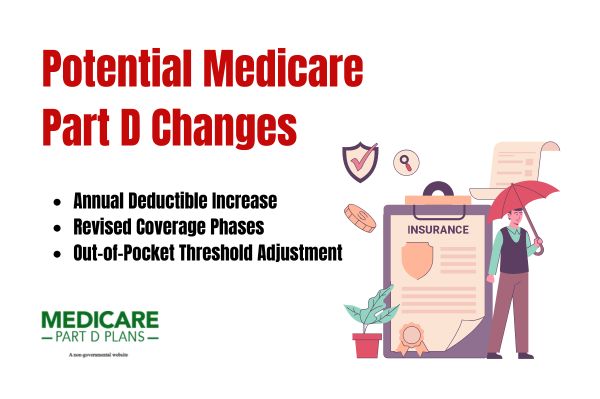Find a Medicare Part D prescription drug plan

Medicare Part D
Prescription Drug Coverage 2026
Medicare Part D Penalty Calculator
Wondering how much the Medicare Part D late enrollment penalty might cost you? A Medicare Part D penalty calculator may provide an estimate. This article will guide you on how to calculate your penalty and understand its impact.
Key Takeaways
- Failing to enroll in Medicare Part D during the initial eligibility period may result in a permanent late enrollment penalty based on uncovered months.
- The national base beneficiary premium will likely serve as a foundation for calculating penalties and may be subject to annual adjustments, likely affecting overall Medicare Part D costs.
- Maintaining creditable prescription drug coverage and utilizing enrollment tools might help beneficiaries avoid late enrollment penalties and effectively manage healthcare expenses.
Understanding Medicare Part D Penalty
Medicare Part D will likely provide prescription drug coverage to beneficiaries, but failing to enroll when first eligible might lead to significant financial penalties:
- The late enrollment penalty for Medicare Part D may be a charge added to your monthly premiums, which could increase your overall healthcare costs.
- If you don’t join a Medicare drug plan during your initial enrollment period, you may face a penalty of 1% for each month you delay enrolling without having creditable prescription drug coverage.
- This penalty will likely accumulate annually and may become a substantial financial burden over time.
The penalty calculation will likely be based on the following factors:
- The number of months you were eligible but did not enroll in a Medicare drug plan and did not have creditable prescription drug coverage.
- For each month without coverage, a 1% penalty is added to the national base beneficiary premium.
- Once imposed, the penalty is permanent and may be charged for as long as you remain enrolled in a Medicare drug plan.
This means that understanding and avoiding the penalty could be crucial to managing your healthcare costs effectively.
The national base beneficiary premium, which is used to calculate the penalty, might change yearly. This variability may further complicate the penalty amount, likely emphasizing the importance of enrolling on time and maintaining creditable drug coverage.
Understanding how the penalty works, and its potential financial implications might allow you to take proactive steps to avoid unnecessary costs.
How to Calculate Your Part D Late Enrollment Penalty
Calculating your Part D late enrollment penalty might seem complex, but it’s a straightforward process once you know the steps:
- Determine the number of months you were eligible for Medicare Part D but did not have creditable prescription drug coverage.
- Multiply 1% of the national base beneficiary premium by the number of uncovered months.
- The resulting amount will be included in your monthly Part D premium.
Therefore, this penalty may affect your overall pay.
For instance, if the national base beneficiary premium is about $34.70, and you had a 12-month gap in coverage, your penalty would be about 12% of $34.70, which equals approximately $4.16. This amount may be added to your monthly premium, which may result in a higher overall cost for your prescription drug coverage.
The penalty may also be rounded to the nearest $0.10, likely ensuring a standardized calculation across all beneficiaries.
Using online tools and calculators may simplify this process. Some Medicare Part D penalty calculators might require you to input your specific enrollment dates and periods without coverage to provide an accurate estimate of your penalty.
By understanding how to calculate your penalty, you may better manage your healthcare budget and potentially avoid unexpected costs.
National Base Beneficiary Premium
The national base beneficiary premium will likely be a crucial component in determining your Medicare Part D premium costs. Based on data from recent years, the premium may be set at $34.70, likely reflecting an approximate 6% increase capped by the Inflation Reduction Act.
This annual adjustment could potentially impact both your monthly premiums and the calculation of any late enrollment penalties. Without these premium stabilization provisions, the base beneficiary premium could have increased to about $39.35 in 2024, likely highlighting the significance of regulatory measures in controlling costs.
Understanding the national base beneficiary premium could be vital because it will likely serve as the foundation for calculating your specific monthly premium for each Part D plan. This premium may be subject to changes each year, likely influenced by various economic factors and regulations.
The annual increase may be limited to a maximum of 6% due to new regulations, possibly ensuring that beneficiaries may be somewhat protected from steep hikes in their premiums.
Keeping track of these potential changes could help you anticipate and plan for your healthcare expenses. Staying informed about the national base beneficiary premium changes may help you understand how your monthly premiums are determined and how potential penalties may be calculated.
Possible Factors Influencing Your Monthly Penalty
Several factors will likely influence the calculation of your monthly penalty for Medicare Part D. One of the primary factors may be the length of time you go without creditable prescription drug coverage. For instance:
- If you fail to enroll in Medicare Part D for 63 days or more without adequate drug coverage, you will trigger the late enrollment penalty.
- The penalty amount will likely be determined by the duration of this gap in coverage.
- The penalty is calculated as a percentage of the national base beneficiary premium.
It’s important to understand what constitutes creditable coverage. Non-Medicare insurance should offer at least the same value as Medicare’s standard coverage to be considered creditable.
If your prescription drug coverage does not meet this standard, the period without adequate Medicare coverage might contribute to the calculation of your penalty. This could make it crucial to verify the status of your current prescription drug plan to avoid unexpected penalties.
The penalty may be added to your monthly premium and could significantly increase your overall healthcare costs.
Understanding the possible factors that might influence your penalty will likely enable you to take proactive steps to maintain creditable coverage and possibly avoid unnecessary financial burdens.
Avoiding Part D Late Enrollment Penalties
Avoiding the Part D late enrollment penalty may be possible with proper planning and awareness. One of the most effective ways to avoid the penalty is by maintaining creditable prescription drug coverage.
This likely means ensuring that your drug coverage meets or exceeds the standards set by Medicare. If you have other prescription drug coverage, such as through an employer or union, make sure it is considered creditable to avoid penalties.
Eligibility for a Special Enrollment Period may also exempt you from the Part D late enrollment penalty. This period allows you to enroll in Medicare Part D without facing penalties if you qualify due to specific life events, such as losing other creditable drug coverage or moving out of your plan’s service area.
Additionally, if you qualify for Extra Help, a program that could assist with Medicare prescription drug plan costs, you may be exempt from paying the late enrollment penalty.
Staying informed about your coverage options and enrollment periods could help you avoid the financial burden of late enrollment penalties. Taking advantage of Special Enrollment Periods and ensuring your coverage is creditable will likely be key steps in managing your Medicare Part D costs effectively.
Using a Part D Penalty Calculator Tool
Utilizing a Part D penalty calculator tool could be incredibly beneficial in managing your healthcare costs. The Medicare Late Enrollment Penalties Calculator will likely provide estimates of potential penalties based on your specific enrollment dates and periods without coverage. While the results might not be guaranteed, they could offer a valuable starting point for understanding your potential costs.
These calculators will likely be designed to help you make informed decisions about your Medicare Part D plan. Inputting your enrollment information allows you to get an estimate of the penalty you might owe and its potential impact on your monthly premiums.
Additionally, tools like the Plan Finder on this website can assist in identifying the least expensive Part D plans that meet your needs, helping you to manage your overall healthcare expenses more effectively.
Using these tools could potentially simplify the process of understanding and calculating your Part D penalties. They could provide a clear picture of your potential costs and help you make informed decisions about your healthcare coverage.
See plans in your area instantly!
Advertisement
Real-Life Examples
Real-life examples may provide valuable insights into how different scenarios affect the Medicare Part D penalty. For instance, consider a person who did not enroll in a Part D plan when first eligible and delayed for 18 months.
This individual may face a late enrollment penalty of about 10% of the national base beneficiary premium, which will likely be added to their monthly premium for as long as they retained that plan.
Another example might involve an individual who had creditable prescription drug coverage but experienced a 12-month gap in that coverage. This person may be subject to a late enrollment penalty calculated based on the months without coverage, which could also be considered over the years.
In contrast, someone who delayed enrollment but later enrolled in a plan offering creditable coverage may be able to avoid penalties by proving their prior sign coverage.
These examples will likely highlight the importance of understanding and maintaining creditable coverage and the potential financial impact of delaying enrollment. They illustrate the real-world consequences of late enrollment and the benefits of proactive planning.
Potential Impact of Part D Penalty on Your Budget
The Part D penalty might have a significant impact on your budget, as it will likely be a permanent addition to your monthly Medicare drug coverage premium. Beneficiaries’ actual monthly premiums might vary widely, ranging from $0 to over $100, depending on their plan.
For higher-income beneficiaries, there may also be an additional income-related premium surcharge, which could range from $12.90 to $81.00 per month.
By being aware of the long-term financial impact of the Part D penalty, you may make informed decisions about your healthcare coverage and plan your budget accordingly. Understanding the penalty and its potential implications will likely be crucial for effective financial management.
Potential Changes in the Part D Premium
The national base beneficiary premium, which will likely be used to calculate the Part D penalty, may be subject to annual adjustments. Based on data from recent years, the premium may be projected to be around $36.78, marking an approximate 6% rise from the previous year.
This annual growth may be capped at around 6% due to regulations implemented by the Inflation Reduction Act, which will likely aim to stabilize premium increases.
Other changes in the national base beneficiary premium might affect how much the late enrollment penalty costs over time. For example, a new demonstration program might be in place to help stabilize premium increases for 2025, possibly limiting them to about $35. Staying informed about these potential changes could help you anticipate and plan for your healthcare expenses more effectively.
Understanding the potential changes in the Part D premium could help you manage your healthcare costs and possibly avoid unexpected financial burdens. Keeping track of annual adjustments and regulatory measures may be essential for making informed decisions about your Medicare Part D coverage.
Find a Plan and Enroll Online Yourself!
Advertisement
Summary
Understanding the Medicare Part D penalty and its potential implications will likely be crucial for managing your healthcare costs effectively. By enrolling on time, maintaining creditable prescription drug coverage, and using tools like the penalty calculator, you could potentially avoid unnecessary penalties and plan your budget more effectively.
Taking proactive steps to understand and manage your Medicare Part D coverage could help you navigate the complexities of the healthcare system with confidence.
Frequently Asked Questions
What is the Medicare Part D late enrollment penalty?
The Medicare Part D late enrollment penalty is an additional charge on your monthly premiums if you fail to enroll in a Medicare drug plan when first eligible and lack creditable prescription drug coverage. This penalty will likely emphasize the importance of timely enrollment to avoid extra costs.
How is the Medicare Part D late enrollment penalty calculated?
The Medicare Part D late enrollment penalty will likely be calculated by taking 1% of the national base beneficiary premium and multiplying it by the total number of months you were eligible without having creditable prescription drug coverage. This could potentially ensure that timely enrollment is incentivized.
Can I avoid the Medicare Part D late enrollment penalty?
You can avoid the Medicare Part D late enrollment penalty by ensuring you have creditable prescription drug coverage or by qualifying for a Special Enrollment Period. Taking these steps could help you avoid unnecessary penalties.
What tools can help me estimate my Medicare Part D penalty?
Using online resources such as the Medicare Late Enrollment Penalties Calculator and the Plan Finder tool on this website can help you accurately estimate your Medicare Part D penalty. These tools will likely enable you to make informed decisions regarding your coverage.
How might the national base beneficiary premium affect the Part D penalty?
The national base beneficiary premium may directly influence the Part D penalty calculation, meaning that any adjustments to this premium might alter the penalty amount you may incur. Thus, staying informed about possible changes in the premium will likely be essential to understand your potential penalty.
Begin Choosing your plan
Advertisement
ZRN Health & Financial Services, LLC, a Texas limited liability company.


